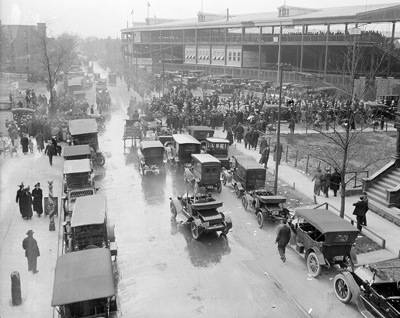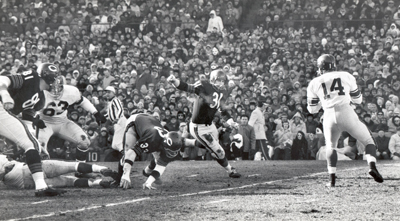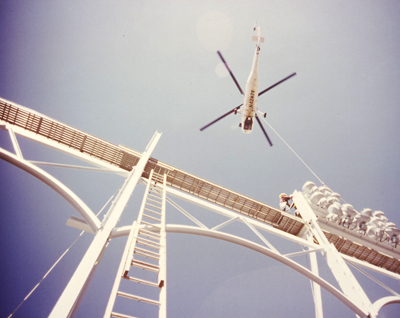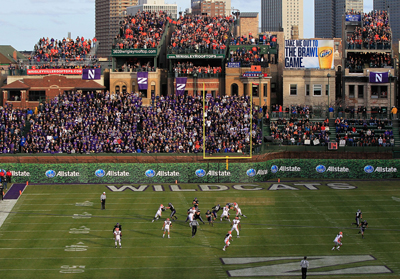1914
 |
The original Weeghman Park, as seen in 1914.
Photo by: Chicago History Museum |
■ Charles Weeghman, a Chicago multimillionaire who unsuccessfully tried to buy the St. Louis Cardinals in 1911, pays $1.92 million for a 99-year lease on a plot of land in the city’s North Side, at the corner of Clark and Addison.
■ The stadium is designed by Zachary Taylor Davis, who also designed Comiskey Park across town for White Sox owner Charles Comiskey in 1910. The original Weeghman Park was a one-level park that was built in two months for $250,000, held 14,000 fans (15,000 fewer than Comiskey) and measured 310 feet to left field, 440 feet to center and 345 feet down the line in right.
■ On April 23, a standing room only crowd of roughly 20,000 pours into Weeghman Park for its inaugural game. Weeghman’s Federal League Chicago Federals, or Chi-Feds, beat the Kansas City Packers.
■ Within weeks of opening, the stadium’s left-field wall is moved farther from home plate and the scoreboard is relocated to center field.
1915
■ The Chi-Feds are renamed the Whales, but the league folds at the conclusion of the season.
1917
■ Weeghman assembles a group of investors, including William Wrigley Jr., to buy the American League Cubs and moves the team from the city’s West Side to Weeghman Park.
■ The Cubs’ Jim “Hippo” Vaughn and the Reds’ Fred Toney each throw no-hitters for nine innings before Cincinnati’s Jim Thorpe (five years after gaining Olympic fame) drives in the game’s only run, in the 10th inning.
1919
■ William Wrigley Jr. assumes primary ownership of the Cubs, starting a family tradition that would last 62 years. The stadium is renamed Cubs Park.
1921
■ The Chicago Bears begin play at the stadium, staying through the 1970 season before moving to Soldier Field. Groundskeepers start dyeing the grass green prior to Cubs home openers.
1925
■ WGN-AM 720 radio begins broadcasting games live from the ballpark.
1926
■ At the conclusion of the season, the ballpark is renamed Wrigley Field.
■ William Wrigley Jr. would pour $2.3 million into stadium upgrades over the next decade, nearly 10 times the stadium’s original construction cost. The left- and right-field grandstands are moved back, and an upper level is added, increasing the ballpark’s capacity to 40,000. The now iconic exterior porcelain marquee is added, as are bleachers, which continue to be a popular place to sit.
1927
■ The Cubs become the first National League team to attract more than 1 million fans in a season.
 |
Wrigley Field, circa 1929.
Photo by: Library of Congress |
1932
■ William Wrigley Jr. dies at age 70; his son Philip K. Wrigley takes over the Wm. Wrigley Jr. Co. and the team.
■ The New York Yankees sweep the Cubs in the World Series, highlighted by Babe Ruth’s famous “Called Shot” during Game 3. The Cubs would also lose the fall classic against Detroit three years later.
1933
■ The Bears win the first NFL Football Championship game over the New York Giants at Wrigley Field.
1937
■ The three-story, 27-foot tall by 75-foot wide, manually operated scoreboard debuts. All of the out-of-town scores are posted as quickly as the ticker tape machine can spit out the updates. It takes three to five people per game to operate the board.
“Let’s say you wanted to change a score on the third floor. By the time you got back to the ticker, that paper was probably 50 feet long.” — Darryl Wilson, who has spent 23 seasons working inside the scoreboard.
■ Inspired by ivy-covered walls that he saw at Perry Stadium, a minor league ballpark in Indianapolis, Bill Veeck Jr., then an assistant to the Cubs’ treasurer, helps plant 200 Boston ivy and 350 Japanese bittersweet plants against the outfield wall. A ball that is stuck in the ivy is a ground-rule double, but if it pops out it’s a live ball.
1941
■ A one-ton, 10-foot white steel clock is added atop the scoreboard. The entire structure is painted green in 1944, since its original seal-brown color reflects sunlight toward home plate.
■ Wrigley Field becomes the first ballpark to feature an organ. Although the experiment lasts only a day, it would return for good in 1967.
■ Unbeknownst to many people, Philip K. Wrigley spends much of the year acquiring 165 tons of steel, copper, cable, electrical equipment and reflectors — everything needed for a lighting system for the stadium — and stores it beneath the bleachers. However, the day after Pearl Harbor was attacked on Dec. 7, Wrigley donates all the materials to the U.S. war effort. Wrigley Field would remain MLB’s only unlit ballpark for more than 40 years.
1945
■ The Curse of the Billy Goat begins when Billy Goat Tavern owner Billy Sianis is asked to leave a World Series game against the Detroit Tigers at Wrigley Field because his pet goat’s odor bothered other fans. He is outraged and declares, “Them Cubs, they ain’t gonna win no more,” which he later says meant that there would never be another World Series game won at Wrigley Field. The Cubs have not won a National League pennant since.
1948
■ WGN begins TV media rights to broadcast from Wrigley Field.
1958
■ Pepsi begins a pouring rights partnership that continues today.
1961
■ Old Style beer begins a partnership that would last more than half a century.
1963
 |
Bears defenders close in on the Giants’ Y.A. Tittle.
Photo by: Getty Images |
■ The Bears beat the Giants in the pro football title game.
1964
■ As several new stadiums are opening or being developed throughout the league, Philip K. Wrigley proposes a new domed stadium that could be shared by the Cubs, White Sox and Bears. A city-funded feasibility report calls for a 55,000-60,000 seat, $34 million multipurpose stadium that would replace Soldier Field. It would have a grass field and an open roof. Bears’ owner George Halas and Wrigley support the plan; White Sox owner Art Allyn does not.
1975
■ The North American Soccer League Chicago Sting would play many home games at Wrigley over the next nine years.
1977
■ William Wrigley III becomes the owner of the team and the ballpark following his father’s death.
1979
■ Budweiser becomes an official beer of the team and ballpark, joining Old Style. Beginning this season (2014), Budweiser will be the exclusive beer partner of the Cubs and Wrigley Field. Old Style will still be poured at select locations in the ballpark.
1981
■ Chicago-based Tribune Co., the owner of Cubs media rights holder WGN, buys the team and stadium for $20.5 million from William Wrigley III.
 |
Harry Caray leads the seventh-inning stretch.
Photo by: Getty Images |
1982
■ Harry Caray starts calling games for the Cubs, becoming one of the most recognized stadium announcers in sports history, hosting dignitaries and leading the crowd every game in the seventh-inning stretch. Caray would continue in that role until retiring in 1997.
■ On Aug. 23, Gov. James Thompson signs legislation passed by the Illinois General Assembly that imposes noise pollution standards “on any pro sport played in a city with more than 1 million inhabitants in a facility in which night sports were not played before July 1, 1982.” A few months later, the Chicago City Council enacts an ordinance that bars night athletic contests on any playing field that is not totally enclosed, has more than 15,000 seats and is within 500 feet of 100 dwelling units. Wrigley Field is the only such facility in Illinois that matches either description.
1984
■ MLB Commissioner Peter Ueberroth tells the Cubs that if lights are not installed at Wrigley, the club’s future playoff games could be moved elsewhere. The following year, ABC exercises a contract clause requiring that all World Series games be played in prime time. Wrigley would add lights three years later, hosting its first night game in 1988.
1986
■ Chicago-based Levy Restaurants begins running the ballpark’s premium food operations. The company would take over the general food, beverage and retail concessions from Aramark in 2005.
1988
 |
A helicopter lowers Wrigley’s first lights into place in 1988.
Photo by: Chicago Cubs |
■ A $14 million renovation includes the construction of 67 private mezzanine suites, a new press box and broadcast booths, upper deck concession stands and a 7,500-square-foot food court.
1990
■ Wrigley Field plays host to the MLB All-Star Game.
2003
■ Oct. 14, 2003; Aisle 4, Row 8, Seat 113. Steve Bartman attempts to catch a foul ball that is being pursued by Cubs outfielder Moises Alou. If Alou had caught the ball, the Cubs would have been just four outs away from winning their first National League pennant since 1945. Instead, the Cubs surrender eight runs in the inning and lose the game, 8-3. The Marlins won Game 7 the next day, too, eliminating the Cubs.
2004
■ The Cubs enter into a 20-year agreement with the rooftop owners in Wrigleyville that addresses longtime issues such as revenue sharing and stadium expansion. About 40,000 people live within a half block of the ballpark, along with 40 bars and restaurants.
2005
■ During the next few seasons, corporate presence begins to appear where it had never been before. The team adds the Bud Patio, the PNC Club, the Captain Morgan Club, an LED message board in right field, a Toyota sign behind the bleachers in left field and an Under Armour sign embedded in the ivy.
■ A $13.5 million renovation begins that will be completed in 2006. It adds about 1,800 outfield seats and improves the ballpark’s aging bleachers.
2007
■ Little Wrigley, a quarter-scale replica of Wrigley Field, opens in Essex, Vt., as a home to major Wiffle ball tournaments.
2008
■ Little Cubs Field opens in Freeport, Ill., an exact replica of the original, albeit a third the size and nearly a century newer.
2009
■ Wrigley plays host to the second annual Bridgestone NHL Winter Classic, as 40,818 fans watch the Detroit Red Wings defeat the hometown Chicago Blackhawks.
■ The Ricketts family pays a reported $845 million to become majority owners of Wrigley Field and the Cubs, and a 25 percent stake in Comcast SportsNet Chicago, which broadcasts many Cubs games. The Tribune Co. retains 5 percent of the package.
 |
Northwestern takes on Illinois as football returns to Wrigley.
Photo by: Getty Images |
2010
■ Northwestern University’s football team loses 48-27 to Illinois in a game played at Wrigley. Because of the limited amount of room between the east end of the field and the right-field wall, both sides have to use one end zone. The school would announce in December 2013 that it will hold 19 events at Wrigley over the next few years, starting with a baseball game against Michigan next month.
2013
■ Tom Ricketts unveils the team’s $300 million stadium improvement plan.
■ Levy Restaurants extends its partnership through the 2021 season.
2014
■ Cubs Park, the team’s new $84 million spring training facility, opens in Mesa, Ariz. It is the Cactus League’s largest ballpark, with a capacity of 15,000. Similar to its Chicago counterpart, the ballpark features a brick wall behind home plate, a small green scoreboard and an old-style clock in the outfield. A replica of the famous Wrigley Field marquee is located on the main concourse, where fans can pose for photos and have their names displayed on the sign.
Sources: Chicago Cubs, “A Century of Wrigley Field: The Official History of the Friendly Confines,” published by MLB; SportsBusiness Journal archives









